Sabudana Vada Recipe
Updated: June 10, 2023, By Swasthi
Sabudana Vada is a popular crisp fried Indian snack made with tapioca pearls (sago), roasted peanuts, boiled potatoes and herbs. These gluten-free and vegan snack are immensely popular as a fasting food among the Indian Hindu community. Sabudana vada are also served as a street food & tea-time snack in many parts of India, especially in Maharashtra.
Learn all the secrets to make these delicious, crisp and fluffy sabudana vada at home with my easy recipe guide. For a healthier option you can also Air fry or bake them, instructions included below.
About Sabudana
Sabudana also known as sago, are starch balls that are obtained by processing the tuberous roots of cassava plants. Also known as Tapioca pearls, these are very commonly used in India and across several Asian countries.
“Sabudana” is a Hindi word for tapioca pearls. These are also known as Javvarisi in Tamil, Sagibiyyam in Telugu and sabakki in Kannada. In India, mostly these are used to prepare festive and fasting foods like Sabudana khichdi, vada and Sabudana kheer.
Sabudana is a highly processed, carb laden ingredient with low essential nutrients like vitamins and proteins. Yet they are consumed widely during vrat/upvas/ fastings in the belief that high carbs will keep us full and provide a boost of energy throughout the day.
As per the tradition, many Hindus fast during Ekadashi & Navratri. Some people consume only milk, some only fruits, while some consume a single meal per day. Apart from Sabudana khichdi and Sabudana kheer, these crisp vadas are a special food eaten during the Navratri & Ekadashi fastings.
What is Sabudana Vada?
Sabudana Vada is a traditional Maharashtrian snack, where patties made of soaked tapioca pearls, mashed potatoes, roasted peanuts, spices and herbs are deep fried until crisp and golden.
During the fasting days, based on the region a lot of ingredients like lentils, certain spices, garlic and onions are not consumed. So the fasting foods like this sabudana vada are made without using any of these ingredients.
Since sabudana is a pure starch, peanuts are used here to add some nutrition. Potatoes bind all of these together.
Many people prefer to eat these with yogurt, Coriander chutney or Green chutney (without garlic). These are best served hot & also go well with hot tea/chai.
This fail proof recipe will give you not only delicious but also crisp sabudana vada that do not soak up much oil. If you are a beginner, do read all my tips and make these like a pro.
Making these is simple and straight forward and you can also prepare these ahead so you can straight away shape and fry them. This saves some time on the day you prepare these vadas. You can prepare ahead the following:
Prepare ahead
- Soak sabudana overnight, drain and refrigerate for 2 to 3 days.
- Roast peanuts and crush them coarsely. Store in an air tight jar upto a week.
- Boil and cool the potatoes. Make sure your boiled potatoes are just cooked and not mushy otherwise sabudana vada will soak up lot of oil.
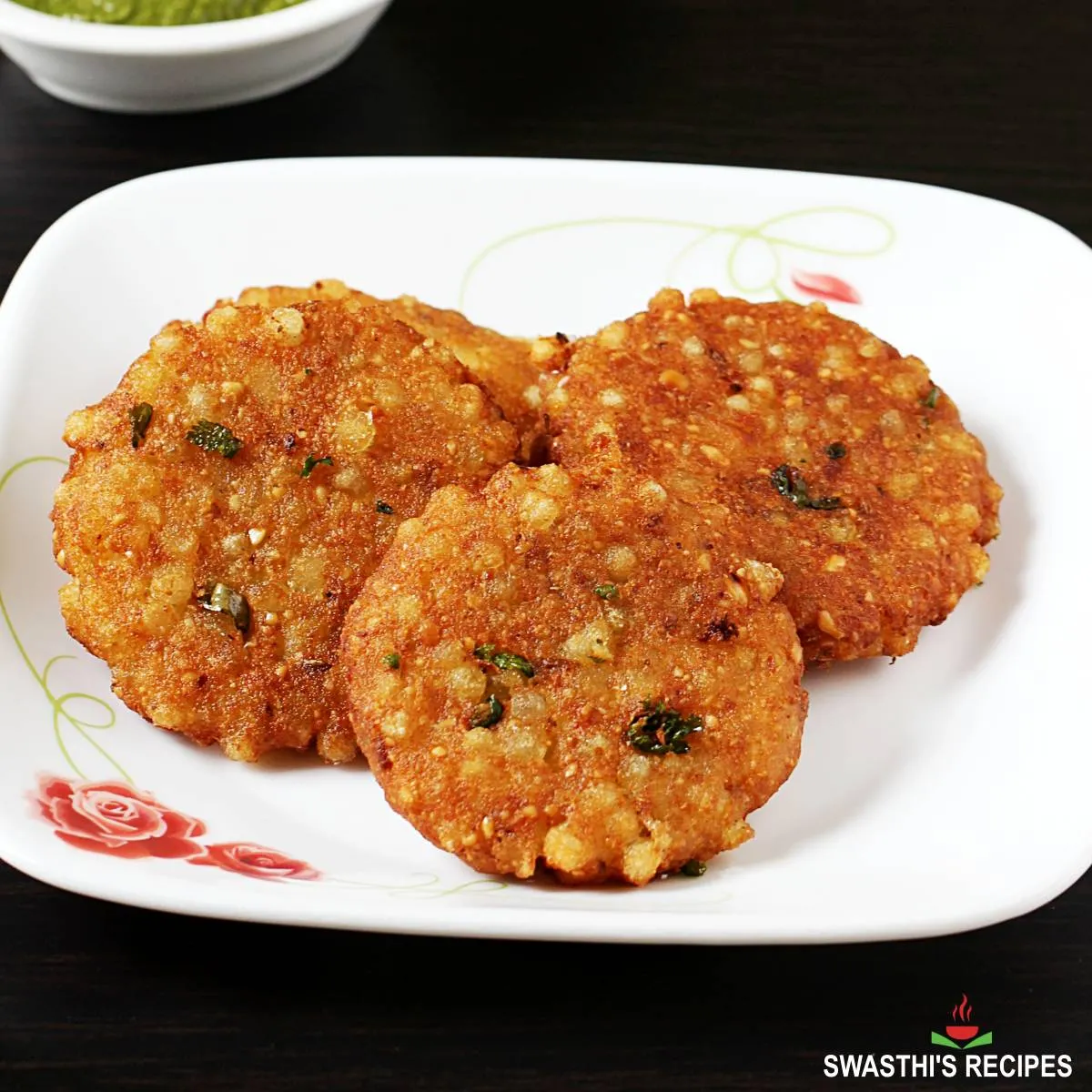
Similar recipes
Medu vada
Batata vada
Vada pav
Dahi vada
Photo Guide
How To Make Sabudana Vada (Stepwise Photos)
Soak sabudana
1. Add half cup sabudana to a wide bowl and rinse them at least twice. While you rinse, rub them well and rinse. Using a wide bowl is very important as it makes a difference to the soaked sabudana.
Drain the water completely and soak them in half cup water for about 4 to 6 hours or overnight. Soaking time depends on the kind of sabudana. Some get soaked quickly some take longer time to soak.
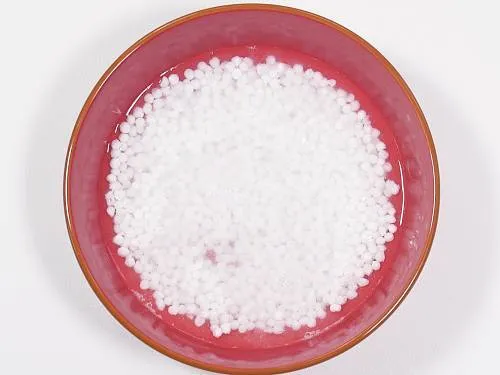
2. Cover and keep them in a cool place.
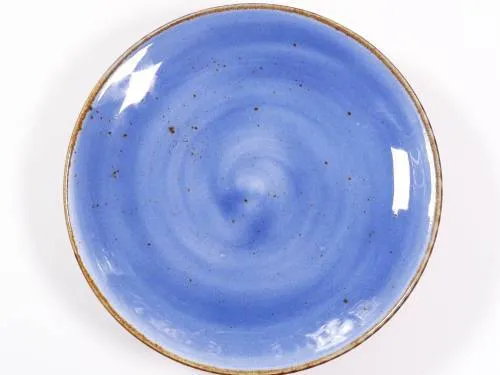
3. Once they are soaked, they double in size and become fluffy. They will soak up all of the water.
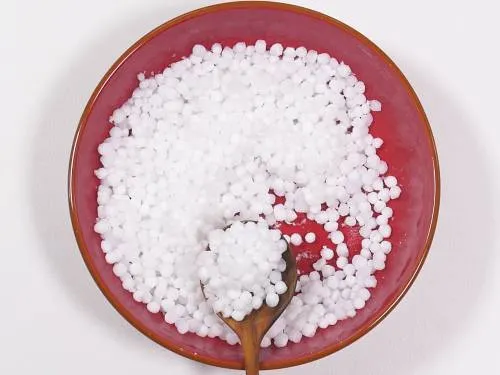
4. It is important to check if the sabudana is soaked correctly and are ready to fry. Any negligence at this step may lead to burst of sabudana in the oil while frying the vadas. So gently press down the soaked sabudana to ensure they are not hard inside and soaked well. When you press down they should ideally get mashed fully and be like flour. It should not have a hard center which will likely burst the pearls while frying.
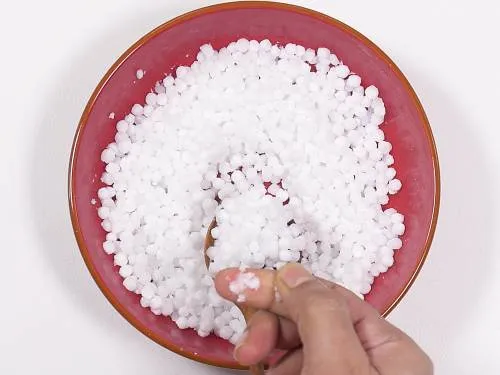
5. Drain up the water completely. To ensure there is no excess moisture in the pearls, drain to a colander and set aside. If there is any moisture left in the sabudana the vada will become soggy and will soak up oil.
Too much moisture in the sabudana can burst them so it is important to drain off any excess moisture and let them air dry for a while until you prepare the peanuts.
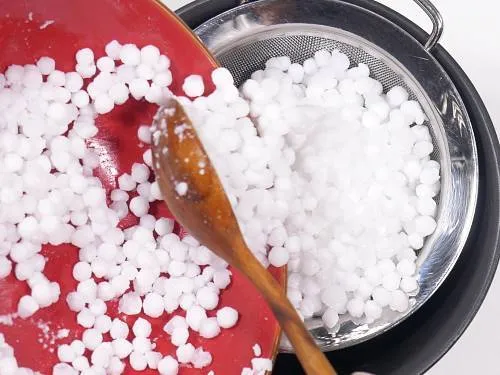
Roast Peanuts
6. Add 1/4 cup peanuts to a heavy pan and begin to roast them on a medium heat until golden & aromatic.
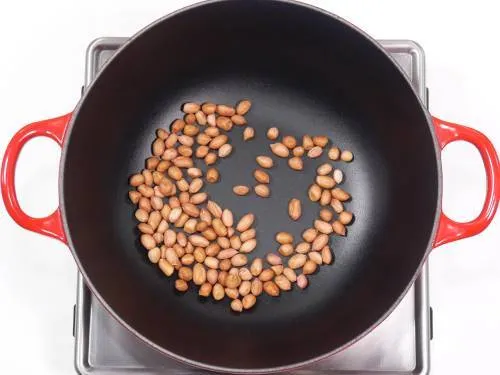
7. When they turn aromatic and done, you will see the skin loosens on its own. Turn off and cool them.
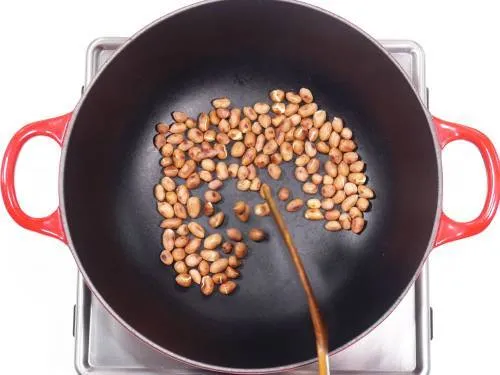
8. Rub them gently and peel off the skin if possible. Then add them to a grinder jar. I did not remove the skin. It is optional.
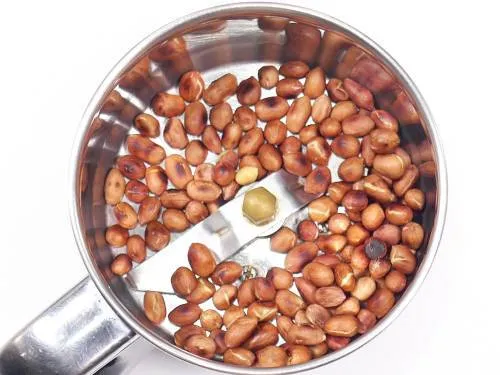
9. Make a coarse powder. Just pulse them once in a blender. We want a coarse powder.
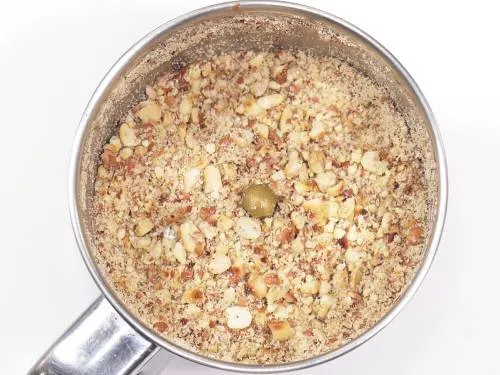
Boil Potatoes
10. Boil 2 medium potatoes in whatever way you like. You can boil the whole potatoes in a cooker for 2 to 3 whistles with 1 cup water or cube them and boil in a pot, by covering the cubes with water. The potatoes must be just fork tender and not mushy. We don’t want soggy potatoes here so don’t overcook them. To check insert a fork , it should easily go in, meaning it is cooked.
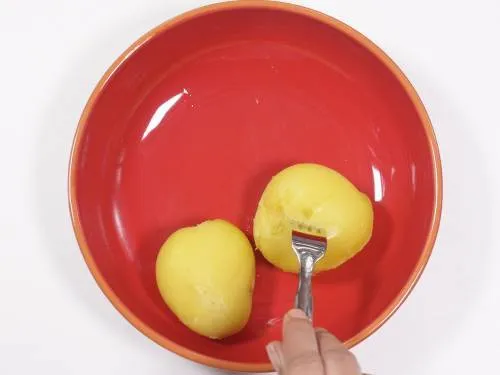
11. Cool and mash them well.
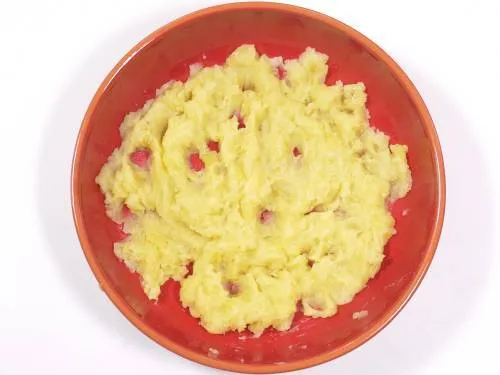
Make Vada Mixture
12. To the bowl of mashed potatoes, add sabudana and mix well.
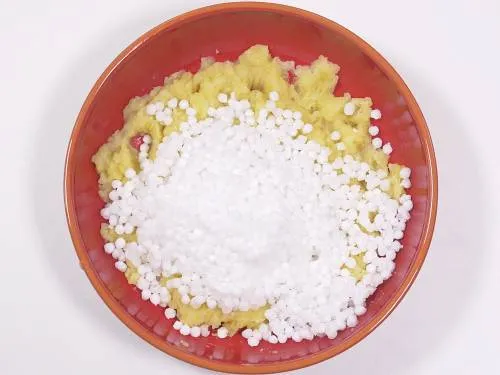
13. Add crushed peanuts, half teaspoon jeera, 1 to 2 chopped green chilies, 1 tablespoon chopped coriander leaves, 1½ teaspoon lemon juice (optional) and ½ teaspoon powdered rock salt. If you want you can also add 1 teaspoon of grated ginger.
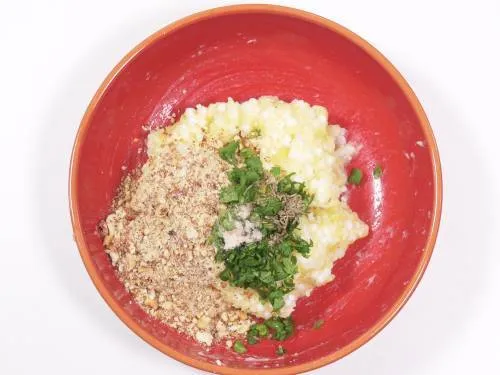
14. Mix everything well. If sticky, then just grease your finger lightly. Mixing well helps in binding the dough well and prevents the sabudana vada from breaking while frying.
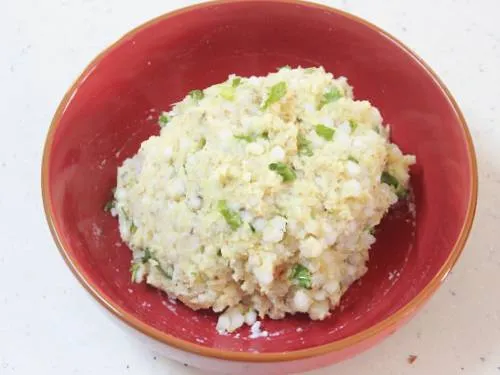
15. Make 10 to 12 equal sized balls from the dough.
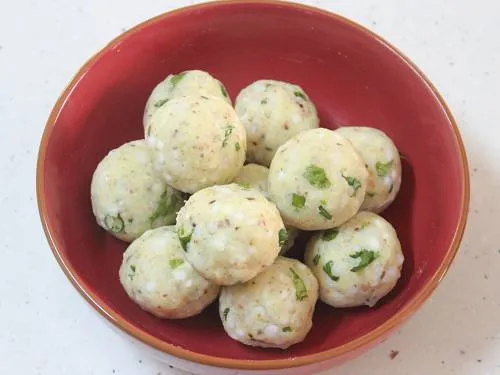
16. Grease your palm and flatten the balls gently to give the shape of a vada. If they break towards the edges, you can just stick them back. Place them in a plate or foil. Do not make them too thick or too thin. The vadas will puff up after frying. Very thick vadas don’t cook inside and very thin vadas may break.
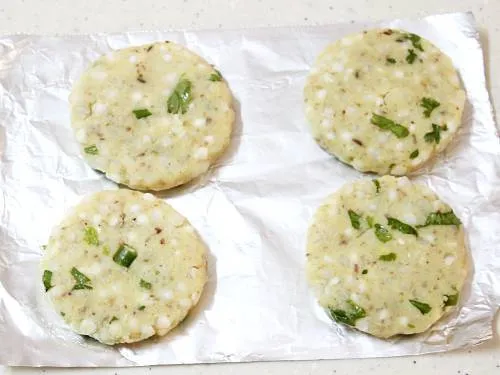
Fry Sabudana Vada
17. Heat oil in a pan until oil turns hot enough. Check by dropping a small portion of the dough to the hot oil. The dough must rise and not sink. This is the right temperature.
Next, take 1 tsp of the dough and shape to a small vada or ball and drop in the hot oil. In case the vada doesn’t break then you can go ahead and fry all of them
If the ball disintegrates in the oil, then add 1 tablespoon flour to the mixture and mix well. If you are fasting then add kuttu ka atta otherwise you can add rice flour. This step is optional only to ensure the vadas don’t get disintegrated in oil.
Shape the mixture to vadas. Gently slide 2 to 3 sabudana vadas to hot oil. Let them fry on a medium heat for a few minutes and firm up. Do not touch them or disturb them until they firm up & become golden. Otherwise they may break. Deep fry them in batches of 2 to 3 on a medium heat.
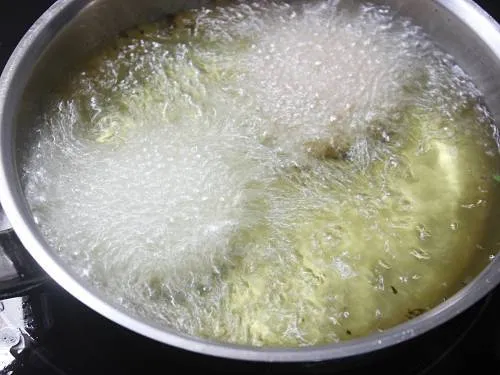
18. When one side of the vada turns firm and golden then flip them to the other side. Fry until golden & crisp on both the sides. Before you fry the next batch, ensure the oil is moderately hot enough again and not very hot.
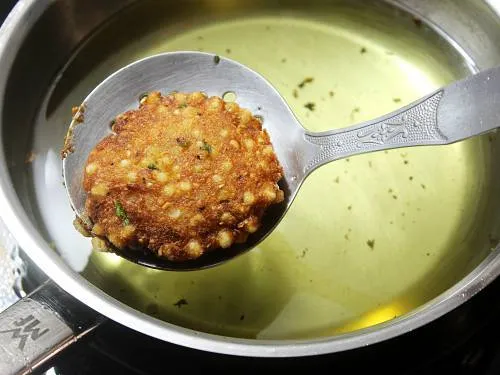
Serve sabudana vada with green chutney or farali chutney.

Pro Tips
1. Soaking sabudana : There are different kinds of sabudana available in the market, some soak up well in just 2 hours while some need 5 to 8 hours of soaking time. Adjust the soaking time as needed until the sabudana turns soft, without any hardness inside.
2. Checking sabudana: After the soaking time, press few sabudana pearls in between your thumb and forefinger. They must get mashed easily. Sabudana if not soaked well can burst in oil. So make sure they are soaked well and not hard from inside.
3. Potatoes : Using old potatoes is essential to make perfect sabudana vada. Using newly harvested potatoes often cook up to a mushy texture which can ruin the vadas.
Boiled potatoes help in binding the mixture. So boil them with care without making mushy or soggy. Soggy potatoes often break up the sabudana vada while frying due to excess moisture.
4. Peanuts : Crushed peanuts help in absorbing the excess moisture if any. So I prefer to powder it. However you can just crush them coarsely in a mortar pestle if you prefer crunchy peanuts in the sabudana vada.
How to prevent them from breaking
1. Using flour : Earlier I had never used flour to make my sabudana vada. It is only a optional ingredient. But lately I have made them many times with flour and felt they are less greasy and more crisp with little flour added.
If your vadas break then you can fix it by adding 1 to 2 tbsps of flour to absorb excess moisture. If making the vadas on fasting days, then you can add some kuttu ka atta or rajgira flour.
2. Temperature of oil : Sabudana vada can break while frying if the oil is not hot enough. Always check if the oil is moderately hot enough to fry. Also fry on a medium high flame. Frying them on a very high flame will brown them too quickly. Frying on a low flame will make them oily.
Faqs – Your Questions Answered
No not at all! Sabudana vada is high in carbs and is also deep fried which makes it a not so healthy food. So try baking or air frying it for low calorie options.
Soaking time for sabudana varies on the type used. While most kinds of sabudana take 5 to 6 hours to soak well, some are hard and need an overnight soak. So experiment and check what works for you.
If sabudana is not soaked well, any unsoaked pearls may burst in oil while frying. Also too much moisture in sabudana can cause them to burst and splatter oil while frying. To avoid this always ensure sabudana is soaked well, mash it to ensure it is soft from inside like flour.
Lack of enough binding can cause the vadas to break. So use good amount of boiled mashed potatoes so they bind the mixture well.
Add more boiled potatoes or some buckwheat flour (kuttu ka atta) or amaranth flour or rice flour for more binding. This will bind the vada mixture better and prevents your vadas from breaking.
Yes you can air fry them at 360 F or 180 C for 14 to 16 minutes, turning after 10 minutes. Shape them flat and thin so they come out perfect.
Yes you can!. Place them on a greased parchment paper and bake at 390 F or 190 C for 30 to 35 minutes or a little longer until crisp.
Variations
- For a healthier option, sometimes I make these with whole grain flour. If you are fasting, then you can easily add some buckwheat flour (kuttu ka atta), amaranth flour or even millet flour like sama flour. You can make these pretty much with any healthy flour like ragi flour, jowar flour or bajra flour. I use about ¼ fine flour in this recipe. Though you can add more, sabudana vadas will pick up the flavor of the flour. I basically use whatever whole grain flour I have at home.
- Potatoes can be easily swapped with sweet potatoes or raw banana. Whatever you use ensure you don’t overcook this binding ingredient. Also with raw banana, you have to mash the mixture very well and knead it a bit so there is enough binding.
- Stuffed sabudana vadas: You can also make stuffed sabudana vadas by stuffing your favorite ingredients. At home we love stuffing some fine chopped cashews and raisins. This only adds some sweetness to the vadas but also adds nutrition.
Related Recipes
Recipe Card
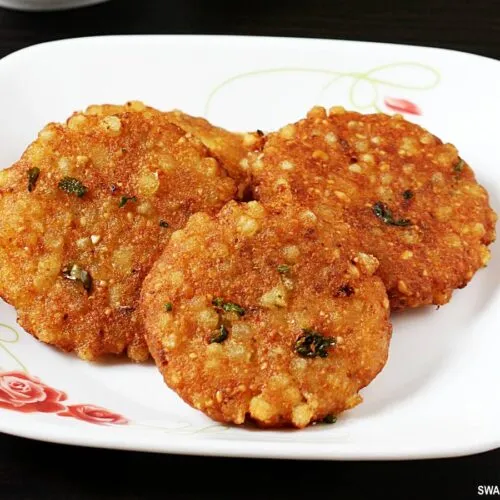
Sabudana Vada Recipe (with Air-fryer option)
For best results follow the step-by-step photos above the recipe card
Ingredients (US cup = 240ml )
- ½ cup sabudana (tapioca pearls, sagu)
- 1 cup potatoes (heaped cup) cubed (2 medium sized)
- ¼ cup peanuts
- 1 tablespoon coriander leaves chopped
- ½ teaspoon cumin seeds (jeera)
- 1 to 2 green chilies chopped (adjust to taste)
- ⅓ teaspoon rock salt powdered (or regular salt if not fasting)
- 1½ teaspoons lemon juice (optional)
- 1½ to 2 tablespoon flour (optional) kuttu ka atta if fasting
- 1 teaspoon grated ginger (optional)
Instructions
Soak Sabudana
- Add ½ cup sabudana to a wide bowl. You can optionally rinse them well twice.
- Then pour ½ cup water and soak sabudana for 4 to 6 hours depending on the kind. You can also soak overnight.
- Some need only 2 hours of soaking while some need at least 5 hours.
- Once they are soaked, take few pearls in between your thumb and forefinger.
- Press down to check if they have softened. The pearls must get mashed well.
- Make sure they are soaked well & softened otherwise unsoaked sabudana may burst in oil.
- You can also bite and check. It should not be hard from inside. If you feel they are hard, soak them for a little longer.
- Drain them completely to a colander and set aside.
Other preparation
- Meanwhile roast peanuts until golden and aromatic. Cool completely.
- Pulse them in a blender only once to get coarsely crushed peanuts. Keep aside.
- Wash and peel potatoes. Boil them just until done and not too mushy or soggy.
- Mash them. If the potatoes are mushy then the vadas may break. So cook them just al dente.
- Mix together sabudana, mashed potato, peanuts, green chili, ginger, salt, cumin and coriander leaves. Add lemon juice (optional) and mix well.
- If the dough turns sticky, then just grease your finger lightly.
- Mixing well helps in binding the dough well and prevents the sabudana vada from breaking while frying.
How To Make Sabudana Vada
- Make 10 to 12 balls and then slightly flatten to make the patties or vada.
- Do not make them too thin as they may break. Making then too thick will not cook them from inside.
- Heat oil in a kadai until hot enough on a medium flame.
- Drop a small portion of the dough to check if the oil is hot enough. The dough has to rise without browning quickly.
- Next take 1 tsp of the mixture in your hand and roll it to a small vada.
- Slide it to the hot oil to check if it doesn't disintegrate.
- If the ball breaks, then add 1 tablespoon flour to the mixture and mix it well. Then shape them to vadas.
- Slide the sabudana vada to hot oil one after the other. Do not crowd them all at one time. Slide only 2 to 3 depending on the size of your pan.
- After adding the vadas, let them deep fry on a medium flame for a few minutes. Do not disturb them or touch them as they may break. When they firm up and become slightly golden, flip to the other side. Fry until golden and crisp.
- The vadas will puff well and turn golden & crisp on the outside.
- Drain them to a kitchen tissue or colander. Serve sabudana vada with green chutney.
Air Fry
- I prefer to shape our sabudana vada thinner so they won't remain chewy and undercooked inside. Shape the mixture to not very thin or very thick patties.
- Place them in the air fryer basket. Air fry at 360 F or 180 C for 14 to 16 minutes, turning after 10 minutes or until crisp and golden. Adjust the timing depending on your air fryer.
- I brush them with ghee as soon as they are out of the air fryer.
To Bake in Oven
- Place them on a prepared tray with parchment paper and preheat your oven for at least 20 mins. Bake at 390 F or 190 C for 30 to 35 minutes or a little longer until crisp.
Notes
- Avoid overcooking the potatoes. If overcooked they will hold up lot of moisture and make the sabudana vadas soggy.
- Drain the soaked sabudana completely otherwise the excess moisture will make the vadas soggy.
- Fry them only a medium heat otherwise they will brown from outside and remain soggy inside.
- You can double fry them to keep them crisp for a little longer.
- I have felt adding atleast 2 tbsps of flour makes the sabudana vada more crisp and less greasy.
- If you are fasting, then use kuttu ka atta or buckwheat flour. If not fasting then you can use rice flour or corn starch.
Video
Watch Sabudana Vada Video
NUTRITION INFO (estimation only)
© Swasthi’s Recipes
Sabudana Vada recipe first published in September 2015. Updated and republished in June 2022.
About Swasthi
I’m Swasthi Shreekanth, the recipe developer, food photographer & food writer behind Swasthi’s Recipes. My aim is to help you cook great Indian food with my time-tested recipes. After 2 decades of experience in practical Indian cooking I started this blog to help people cook better & more often at home. Whether you are a novice or an experienced cook I am sure Swasthi’s Recipes will assist you to enhance your cooking skills. More about me
Follow Swasthi’s Recipes

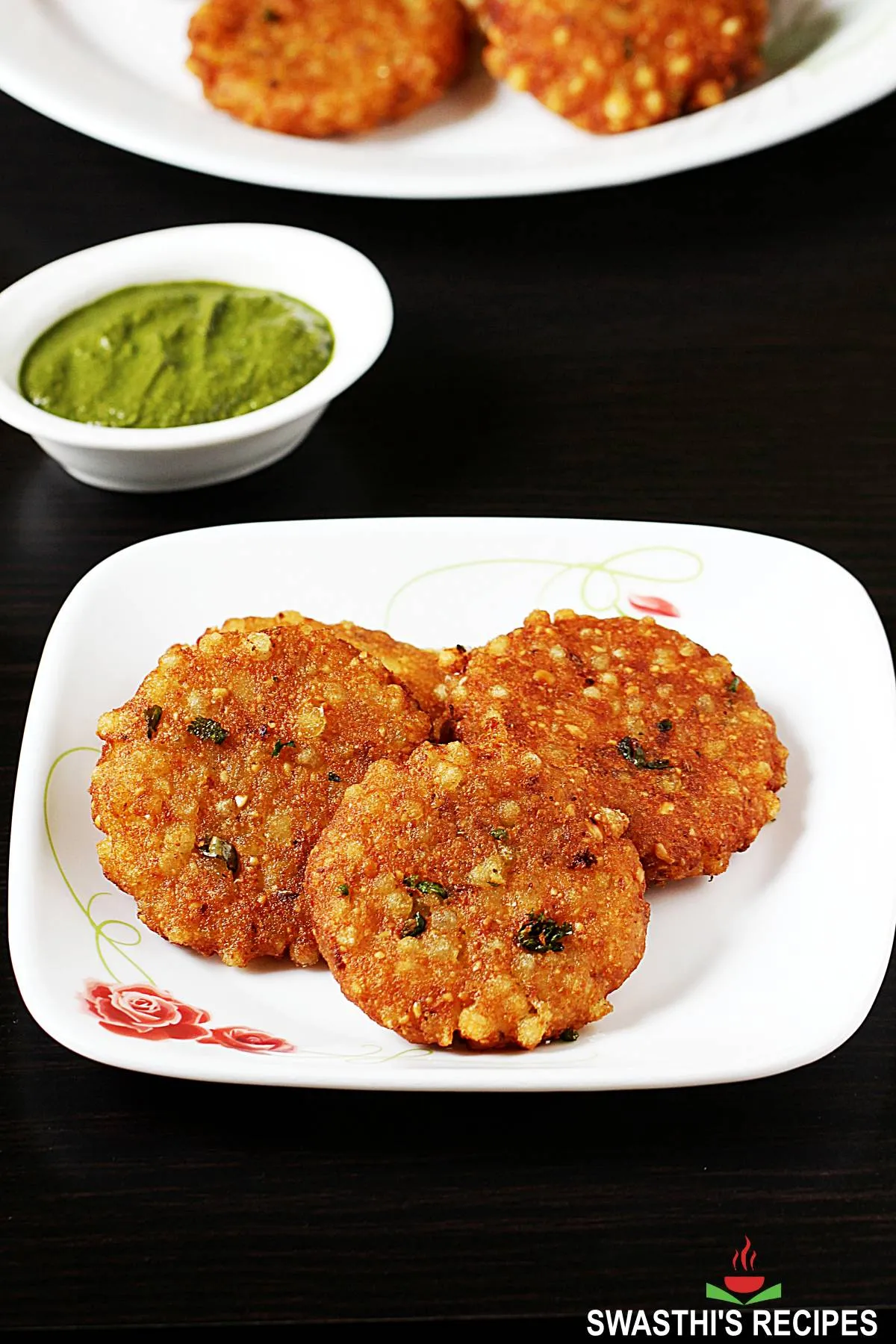
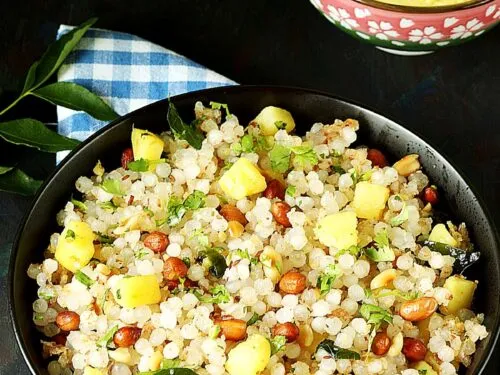
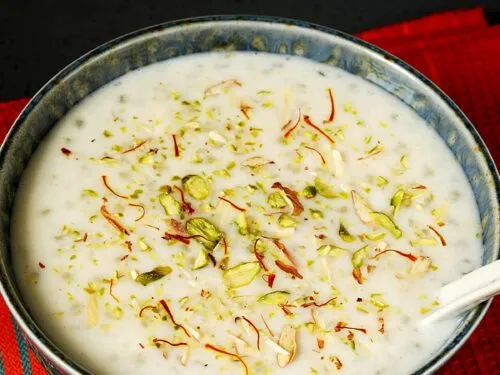
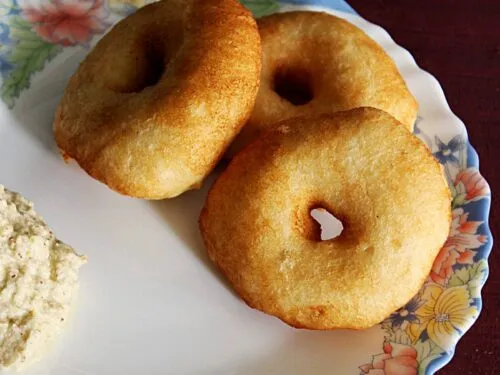
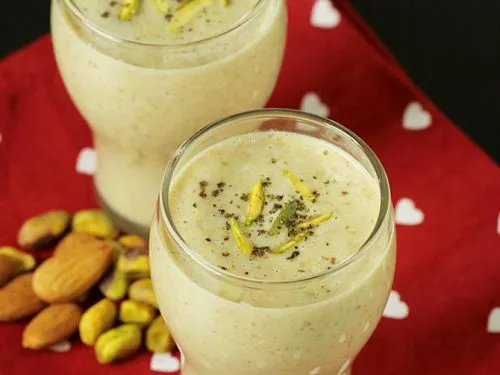
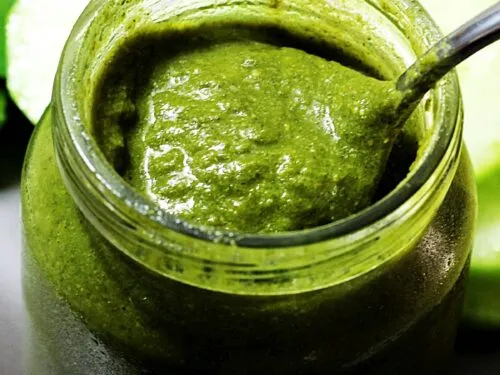
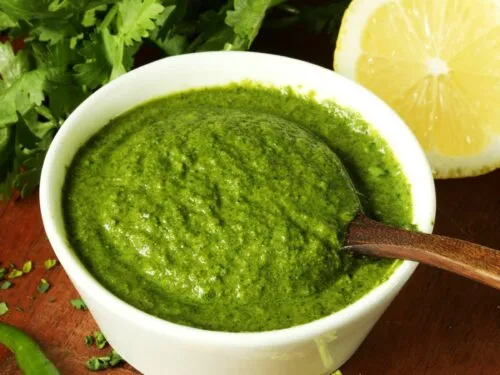
Comments
Fantastic! I fried my sabudana vada in the air fryer and they were “wow”!!
This recipe looks fantastic! I love how simple and nutritious puffed millet is—such a great addition to a healthy diet. Can’t wait to try it out. Thanks for sharing!
The Sabudana vadas turned superb. Thank you for your receipe.
Happy to read that Kasturi. Thank you
Great recipe! I made a large batch of dough to make them on 3 different days. The first day I fried them and the next 2 days used my air fryer. Both the ways they tasted great. Your coriander chutney is delicious too. Thank you and keep posting
So glad to read that Rupali. Appreciate your time to share back. Thank you so much
I added soaked channa dal too like in masala Vada
Wow! That’s a nice thought Vijaya. Thank you for sharing
You’re recipes are awesome. They just turn perfect.Simply amazing .I have almost tried all your recipes and every recipe has turn out best.
Thanks to you
You are welcome Saleena. So glad to read this. Thanks for writing
Made it for the first time… everyone loved it 🙂 I’m a big fan of your recipes… Your site is the first place I check when I have to try out a new recipe.. Thank You ❤
Happy to read this Karuna. Thank you so much!
🙂
First time making and they were perfect and Delicious!
Glad to know Om. Thank you
Baked them in the oven, they came out delicious. I think they are the best sabudana vada I made.
So glad you like them Nandita. Thank you
The sabudana wada turns awesome…!! Thank you for simple recipe with great tips. My family enjoyed it a lot.
Thank you so much Arti. So glad you all liked it.
Beautiful recipe and so clearly written. I made these sabudana vada a lot of times with great success but sometimes I don’t know if I’m choosing the right kind of potatoes. How do you identify new potatoes?
Thank you Rathi. Actually new potatoes have light colored & thinner skin. They also have high moisture so you can make out from the freshness. Hope this helps
Can I refrigerate soaked Sabudana for 3 to 4 days? Will they vadas turn out good. TIA
They can be kept for 2 days. Not sure about 3 to 4 days. Sabudana vada turns out good even with refrigerated ones.
My family loves sabudana vada. I usually make a large batch and refrigerate the dough. We air fry through the week for snack. They taste delicious with coriander chutney.
Wow! That’s good to know!
Love this sabudana vada recipe. Baked them in the oven. They took longer around 45 mins & did not brown much but tasted delicious and were crisp. Thank you
Thanks for trying Archana. The time taken depends on the kind of oven. Usually larger ovens take longer time. To get brown crust, broil them for 2 mins at the end. Hope this helps.
You made the entire process so simple. Your tips are so practical. I made and the vadas turned out very good. Thank you for the wonderful recipe.
Thank you Navneeta. Glad the vadas turned out good.
Excellent receipe
Thank you Anjali
I tried to make this Sabudana vada at home yesterday. This is the best recipe in my whole life I’ve tried. The crispiness in this vada remained perfect even after so many hours and my husband just loved it! I’m so much addicted to your recipes that Google shows me only your recipes when i search for any dish
Thank you so much Manisha!
So happy to know the recipe worked well. Thanks Again
Thanks for this amazing recipe. My sabudana vada turned out very good this time. Using old potatoes seem to be the right thing
Hi Ananya
Glad to know! yes! Thank you
Hi your recipes are great. However I would suggest giving the measurements in grams or ml for greater accuracy. Cup sizes can vary – 240 ml doesnt always make sense -how do you measure one third cup peanuts for instance? WEIGhing ingredients is best and INDian households who have access to internetcan afford a set of kitchen scales.
Followed your sabudana vada recipe. Turned out perfect. Thank you.
Thank you
Very well explained! Appreciate it!
Thanks Ankita